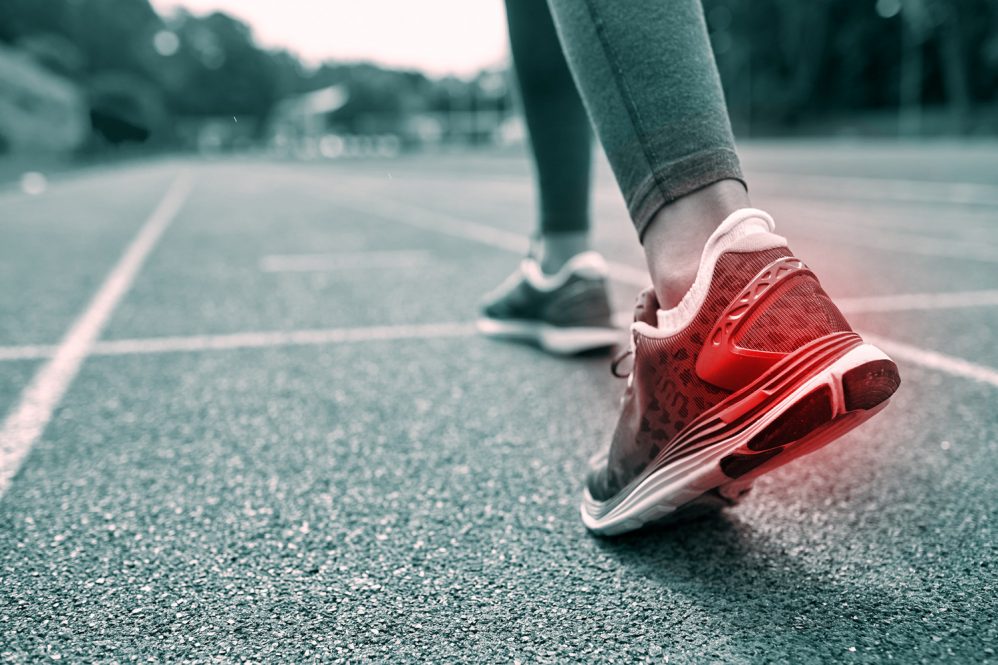While you may be training for the upcoming Hartford Marathon Foundation UConn Health Half Marathon or other races this summer, no matter how much you train, your feet play a starring role in your running, and they take a beating withstanding force up to three times your body weight with each step. It’s no wonder runners often suffer from foot pain from running.
According to Michael Scanlon, podiatrist and assistant professor of Orthopedic Surgery at UConn Health for those running the UConn Half Marathon or other races, the biggest issue is pressure blisters. These will happen during the race and most commonly are associated with poor-fitting shoes or the wrong kind of socks.
For any runner, a properly fitting pair of shoes is key to preventing many feet problems. Scanlon suggests going to a reputable shoe store with foot specialists who focus on running to have your feet fitted with the appropriate pair of shoes that fit your size and your gate is the first step for any runner.
Socks are another important part of your running gear with synthetic fibers such as polyester and nylon that are sweat-wicking and breathable providing a more durable option than cotton.
While properly fitting shoes and socks don’t mean you will never get a blister, it will lessen the chances. If you do get a blister Scanlon recommends draining the blisters and wrapping to provide a little compression. You will need to drain every six to eight hours. Use a clean sharp needle with rubbing alcohol. Use the needle to prick the blister in several spots near the edge. Let the fluid drain but leave the overlying skin in place.
Scanlon advises against deroofing the blister which removes the skin from the blister. A deroofed blister is more painful, more open to infection, and takes longer to heal. If this happens to your blister while running, you will want to use an antiseptic and keep the blister covered with a bandage.
Another day of issue is numbness in the foot and toe. This is from pinched nerves that affect the toes.
“You will get runners at the end of the race say that their toes are numb, and they can’t feel them, or they feel fat and swollen,” says Scanlon. “What’s going on is you bruised a nerve and it will go away on its own.”
Some of the issues that will start to show a few weeks or so after the race include plantar fasciitis and stress fractures.
Plantar fasciitis is probably the most common cause of foot pain from running. Your plantar fascia is a web-like tissue that stretches across the bottom of your foot from your heel to your toe. Pain from plantar fasciitis is most commonly felt in the heel or in the arch of the foot where the heel graduates into the arch. The pain can be a sharp stabbing pain and/or a dull ache.
If your plantar fascia becomes too tight, it can become inflamed, strained, or even torn. If you suspect you have plantar fasciitis, it is best to take care of it right away as it can become inflamed quickly and is hard to get rid of.
Traditional treatment for plantar fasciitis is rest, ice, elevation, and anti-inflammatories, most people with this condition will stretch, and roll tennis balls and frozen water bottles on the bottom of the foot to try to prevent or lessen this condition.
Stress fractures are another issue that will rear their head weeks after the race. There are 26 bones in your foot, and these bones are under a lot of stress when you’re running. If you have acute, localized pain, there is a good chance one of these bones could have a stress fracture. These tiny cracks or severe bruising are a common overuse injury in runners—typically in the metatarsal bones (the middle bones of your foot). They can also be in the heel, ankle, or top of the foot (navicular).
“Stress fractures can be a nagging debilitating injury for months, it’s going to be a dull throbbing ache worse with activity and better with rest,” says Scanlon. “Patients will come in after several months and say they rested and took anti-inflammatories but as soon as they start running again, they have pain.”
The last thing a runner wants to hear is that they need to immobilize, but if they continue to run through the pain and don’t fix it, it is going to get worse to the point where they could end up developing a complete fracture which could mean surgery.
Beyond the correct shoes, Scanlon says the best way to prevent many of these issues is a good foot exam.
“Many runners come into my office and are concerned I’m going to tell them to stop running,” says Scanlon. “That’s not necessarily the answer, it’s more like looking at a preemptive strike to avoid these issues.”
By understanding your foot type and what you may be prone to developing there are several options to help you avoid issues.
“While, even with precautions, I’m not saying some of these issues are not going to happen, but you’re bettering your odds of preventing that type of injury,” says Scanlon.



